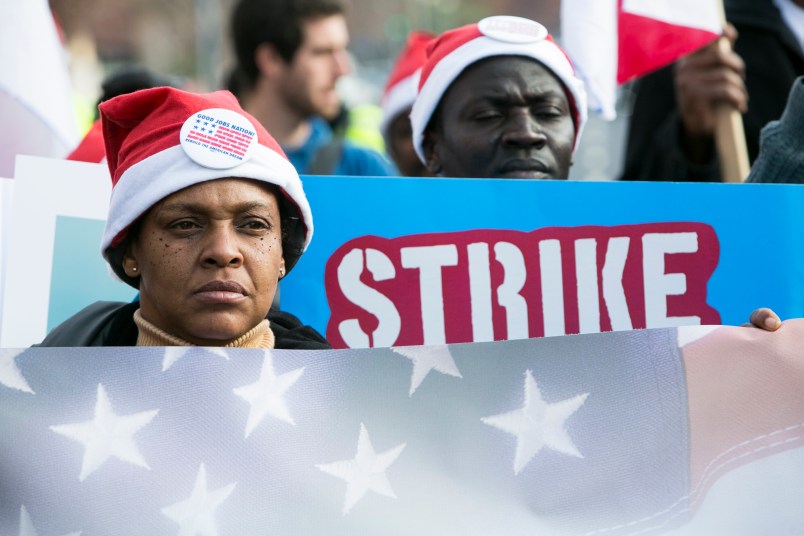This is part of TPM Cafe Book Club for Jake Rosenfeld’s What Unions No Longer Do.
Rosenfeld’s latest contribution to this here book club is especially timely. For the past few weeks, the liberal commentariat has been having one of its perennial debates over whether the labor movement is dying and, if so, whether we should mourn its passing. This particular iteration of the old back-and-forth was kicked off by Bloomberg View columnist Evan Soltas, who argued that American unions are as good as dead and that’s pretty much okay.
According to Soltas, the primary function of unions is to promote the narrow interests of their dues-paying members and “provide a voice for workers that management can hear.” As a side benefit, unions also sometimes improve workplace productivity and reduce turnover, so everybody wins. It would be a shame if workers lost their voice and productivity took a hit, says Soltas, but there are technocratic fixes to those problems (such as better monetary policy) which can achieve a positive result for all without recourse to fundamentally selfish labor cartels.
 Needless to say — because so many others have already said it in the intervening weeks — this line of thinking relies on a historically suspect understanding of how unions operate. The movement is not a monolith, and some unions will always pursue their own self-interest at the expense of all else, but even a cursory glimpse at American history should belies the idea that myopic acquisitiveness is somehow an intrinsic feature of organized labor. In fact, as Rosenfeld notes, so-called “cartels” of self-interested workers have always played an irreplaceable role in the struggle to lift standards for the entire working class.
Needless to say — because so many others have already said it in the intervening weeks — this line of thinking relies on a historically suspect understanding of how unions operate. The movement is not a monolith, and some unions will always pursue their own self-interest at the expense of all else, but even a cursory glimpse at American history should belies the idea that myopic acquisitiveness is somehow an intrinsic feature of organized labor. In fact, as Rosenfeld notes, so-called “cartels” of self-interested workers have always played an irreplaceable role in the struggle to lift standards for the entire working class.
That’s why there’s no top-down, technocratic fix to the hegemony of the boss: The technocratic class is unlikely to do anything of note for the working poor’s living standards unless they’re forced to. The power of organized labor rests not just in its ability to bargain with individual managers, but in its capacity for disruption on a massive scale. This country’s economy has become more egalitarian and more progressive when the working class has used that power to extract concessions from the elite.
A classic example of massive disruption put to good use would be the General Motors Sit-Down Strike of the mid-to-late 1930s. By attacking the most powerful car manufacturer in the United States, the United Automobile Workers (UAW) sought to transform the whole industry. Their victory was a pivotal moment in the fight to better living standards throughout American manufacturing, and therefore the working class as a whole, but it didn’t come easy: In order to get there, strikers had to occupy a GM plant and hold it against violent attacks from the local police department. When GM finally agreed to bargain with UAW, it was a victory for raw labor power first and foremost.
Not all confrontations between the rich and poor need be that dramatic, but the fact remains that power respects only power. The only way to improve the fortunes of the working class is to demonstrate that it has sufficient capacity to undermine any economic status quo in which it doesn’t get a fair share.
Note that this doesn’t mean organized labor exists to provide a “countervailing force” to capital, which is how Mother Jones’ Kevin Drum characterized its mission in his response to Evan Soltas. There can be no enduring balance or harmony between workers and the boss; history never makes accommodations for that sort of lasting stability, and the only reason we pine for it now is because the post-World War II status quo briefly made the dream of a balance between class interests seem at least semi-plausible. We don’t have the luxury of such illusions now. So long as there is class, there will be class struggle.
The question, then, is what shape that struggle will assume in the future. Soltas and Drum may very well be right in at least one regard: The modern American union is a historically idiosyncratic phenomenon, shaped by legal institutions which emerged only in the mid-20th century. That form of organized labor was never going to last forever, but that doesn’t mean labor will stop organizing once it’s gone. Unions were around long before the passage of the National Labor Relations Act, and they’ll be around long after the post-NLRA labor system has crumbled. What they’ll look like then is anyone’s guess.
Ned Resnikoff is a reporter at msnbc.com, covering issues of class, labor, inequality and climate change.






